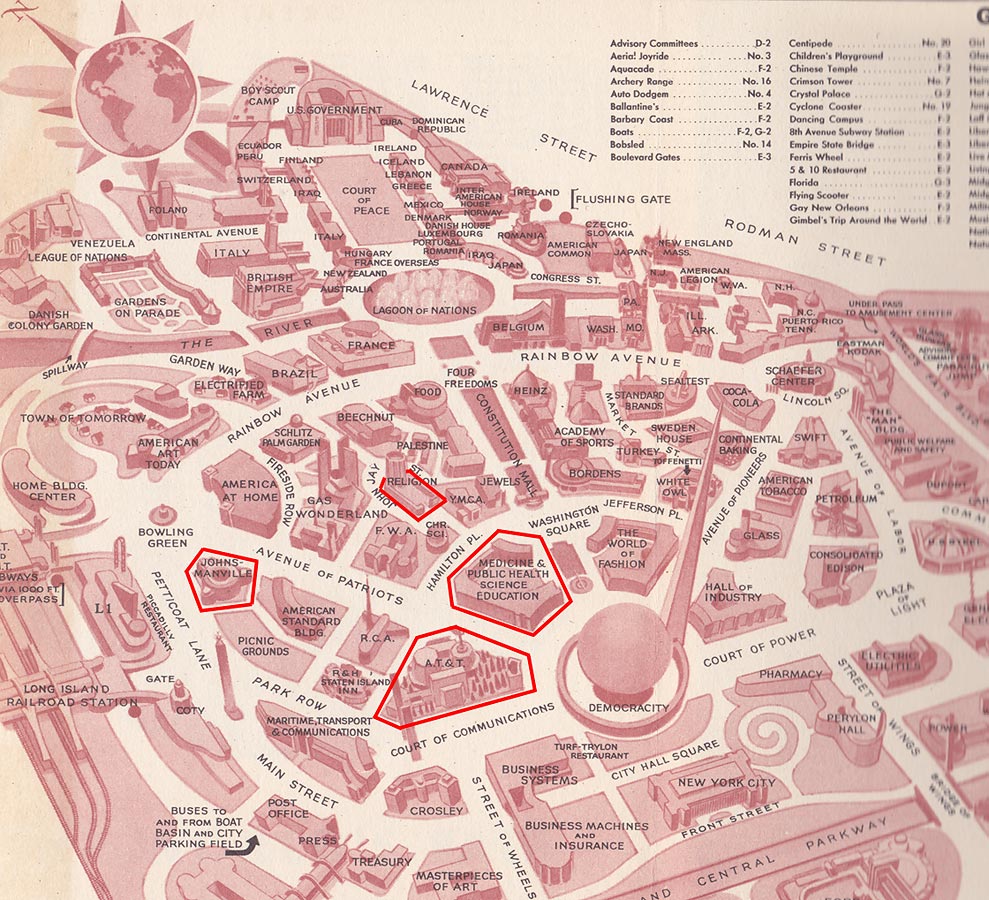Hildreth Meière Documentary Series - Watch Trailer
Hildreth Meière Documentary Series - Watch Trailer

Detail of map from Official Guide Book – New York World's Fair 1940 showing locations of four buildings with murals by Hildreth Meière
Hildreth Meière was well connected to the members of the Board of Design at the 1939 New York World’s Fair. They were responsible for recommending artists to the World’s Fair Corporation. Meière’s relationships went back to her days as an art student, when she studied with Ernest Peixotto, who was mural consultant for the fair. In 1936, she had succeeded Peixotto as Director of the Beaux Arts Institute of Design in New York, a position she held for five years.1 She had also succeeded Peixotto as president of the National Society of Mural Painters.2
Meière had worked with Voorhees, Gmelin & Walker on One Wall Street and the AT&T Long Distance Building in Manhattan. Stephen Voorhees, as president of the American Institute of Architects, was responsible for the standards governing murals at the fair. His firm Voorhees, Gmelin, Foley & Smith asked Meière to design exterior murals for their AT&T Building at the fair.
Kohn, Butler & Stein, the firm of Robert Kohn, who oversaw the main theme of the fair, “Building the World of Tomorrow,” had designed Temple Emanu-El, where Meière had decorated the main sanctuary.3 Kohn’s partner, Clarence Stein, together with Alfred Easton Poor and Oliver Regan, commissioned Meière to design decoration at the fair for the Temple of Religion.
Having worked with Meière on their building at 25 West 43rd Street, where she had provided them with two murals inside the 43rd and 44th Street entrances to the lobby in oil on canvas, the firm Shreve, Lamb & Harmon commissioned Meière to decorate the main entrance to the Johns-Manville Building.
Finally, Mayers, Murray & Phillip, Bertram Grosvenor Goodhue’s successor firm, with which Meière had a long history, gave Meière nine separate commissions to decorate the facades of the Medicine and Public Health, Science and Education Buildings.
In all, as a result of her previously established relationships, Meière received eleven commissions to design murals for the exteriors of four separate fair buildings in a variety of mediums. She explained what this entailed:
This sounds fairly simple, but one scheme called for six separate compositions, two of them were of two compositions each, and one was a hundred and fifty feet long, and I not only designed painted murals, but for mosaic, terracotta, gesso relief, and metal as well.
She continued:
All of my work was for the outside of the buildings; what I did had to “carry” and it had to be simple. I had studied the Paris Exposition of 1937 very carefully, and I think I learned a great deal from it, for nothing is so helpful as seeing what others have done with your problem. You learn even more from their failures than from their successes, for successful things have a deceiving way of looking easy. I believe that good exterior decorations are uncomplicated and easy to read, and that the heavy, the involved, and the gloomy have no place on the outside of a World’s Fair building.4
Footage shot by Hildreth Meière documenting the eighteen murals and friezes she designed for four buildings. Courtesy of the Archives of American Art, Smithsonian Institution, Washington, D.C.
For a full discussion, see Catherine Coleman Brawer and Kathleen Murphy Skolnik, The Art Deco Murals of Hildreth Meière (New York: Andrea Monfried Editions, 2014): 178-91.
Meière was president of the National Society of Mural Painters from 1936-37 and again from 1946-49.
Mayers, Murray & Phillip, as associate architects, had been commissioned to decorate the interior of Temple Emanu-El. They hired Meière.
Hildreth Meière, “Working for a World’s Fair,” Journal of the Associated Alumnae of the Sacred Heart 4 (1939-40): 36-37.